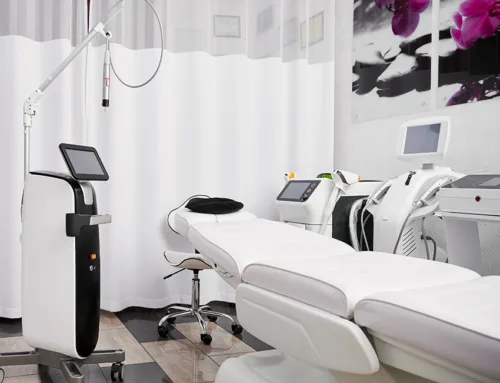Top Healthcare Business Marketing Strategies for Rapid Growth
This article explores key strategies for effective healthcare business marketing, which is essential for attracting and retaining patients while enhancing the visibility and competitive advantage of healthcare providers.
Key Takeaways
- Effective healthcare marketing strategies are essential for attracting and retaining patients, and leveraging consumer data to enhance engagement and brand loyalty.
- A comprehensive marketing approach should combine digital and offline strategies, including SEO, PPC advertising, and community events, to maximize visibility and foster trust.
- Regular measurement of marketing performance through key performance indicators (KPIs) and analytics tools is crucial for refining strategies, improving patient satisfaction, and driving business growth.
Understanding Healthcare Business Marketing
Marketing in the healthcare sector involves strategically reaching healthcare consumers to meet their evolving needs and preferences. These consumers are becoming more proactive in managing their health, seeking convenience and personalized care. As a result, healthcare marketers must adapt their strategies to resonate with this informed audience.
By leveraging clinical insights and consumer data, healthcare providers can craft messages that resonate personally, fostering trust and loyalty. Consistency across touchpoints is vital to maintain patient confidence and ensure seamless experiences throughout their healthcare journey.
Benefits of Effective Healthcare Business Marketing
Effective healthcare marketing is crucial for organizations looking to build a strong digital presence, attract new patients, and maintain engagement with existing ones. By employing data-driven and strategically designed efforts, healthcare providers can connect with individuals at various stages of their health journeys, fostering trust and loyalty.
For instance, implementing tools like an Engagement Center can significantly enhance communication between patients and providers, strengthening relationships and boosting patient loyalty. Additionally, integrating automated systems into retention strategies increases their efficiency and impact, helping organizations maintain a loyal patient base.
The benefits of strategic healthcare marketing extend beyond patient acquisition and retention. These efforts drive practice growth and improve financial outcomes by building sustained trust and confidence among patients. For smaller healthcare providers, effective marketing levels the playing field, enabling them to compete with larger entities by consistently attracting and retaining patients.
By combining strategies that focus on acquiring new patients, retaining existing ones, and fostering organizational growth, healthcare providers position themselves to thrive in an increasingly competitive landscape. Such approaches not only improve patient relationships but also contribute to the long-term success and sustainability of the organization.
Enhancing Patient Acquisition
In healthcare marketing, a strong brand presence is essential to attract prospective patients. With individuals increasingly searching for health-related information online, especially post-pandemic, providers must adopt marketing strategies that resonate with tech-savvy healthcare consumers.
Targeted initiatives, such as direct mail campaigns, can effectively showcase specialized services, often yielding higher response rates than email campaigns. By analyzing patient behavior and identifying key interaction points, healthcare providers can craft strategies that drive patient acquisition.
Improving Patient Retention
Retaining existing patients is significantly more cost-effective than acquiring new ones and fosters long-term loyalty while encouraging personal referrals. Consistent communication with patients strengthens their connection to the practice, enhances satisfaction, and promotes organic word-of-mouth recommendations. Tools like patient portals play a crucial role in streamlining communication, directly contributing to higher levels of patient contentment.
Engagement can also be cultivated through active participation in local community events, fostering stronger ties with residents and reinforcing the practice’s presence within the community.
Developing tailored communication strategies further strengthens trust and reliability, which are fundamental to building lasting patient relationships. By customizing interactions to meet individual preferences and needs, healthcare providers create a more engaging and satisfying patient experience. This personalized approach not only helps retain existing patients but also improves the public perception of the practice, positioning it as a trustworthy and patient-centric organization.
Boosting Brand Awareness
Enhancing brand awareness is essential for healthcare providers to build recognition and trust among patients and peers in the medical community. A strong, consistent brand identity helps distinguish a provider from competitors and solidifies their position in the market. Achieving this requires effectively communicating the provider’s values, mission, and unique qualities through a range of targeted marketing strategies.
Traditional print advertising remains a powerful tool for increasing visibility and strengthening a provider’s reputation within the local community. Ads placed in regional publications often carry a sense of legitimacy and trust that online channels may not always achieve, making them an effective way to reach local audiences. Strategic use of these placements helps establish a robust local presence and fosters greater confidence in the brand.
Additionally, active involvement in community events reinforces brand loyalty and demonstrates a genuine commitment to the health and well-being of the local population. Such engagement not only boosts visibility but also builds lasting connections with the community, further enhancing the provider’s reputation.
Key Components of a Successful Healthcare Marketing Strategy
A successful healthcare marketing strategy must align with the organization’s overarching goals to support business objectives, attract high-value leads, and drive revenue growth. It involves several key steps:
- Establishing objectives
- Identifying target audiences
- Articulating a distinctive value proposition
- Coordinating the marketing mix
By leveraging consumer and market data, healthcare marketers can craft personalized messages tailored to specific demographics, ensuring outreach efforts resonate with intended audiences. Robust analytics are vital for tracking performance, refining strategies, and optimizing budgets in real-time.
Adopting healthcare-specific technology platforms further enhances execution, enabling marketers to implement, evaluate, and adapt sophisticated strategies efficiently.
Defining Your Target Audience
Precisely identifying the target audience is critical for any healthcare organization. Research shows that 83% of healthcare consumers prefer personalized experiences. By creating patient personas based on data, healthcare marketers can gain insights into patient preferences, needs, and behaviors.
Personalization achieved through segmentation allows for tailored messages that deeply resonate with audience subsets. For instance, segmenting email lists ensures each group receives content aligned with their healthcare needs. Tracking consumer behavior and analyzing demographics enables marketers to deliver timely, relevant offers, resulting in targeted and meaningful interactions.
Setting Measurable Goals
Setting measurable goals is essential for tracking the success of healthcare marketing initiatives. SMART goals should be clear, specific, and effectively measure success in achieving desired outcomes. An example of a SMART goal is to improve patient acquisition by a certain percentage over 12 months. Basic marketing KPIs consist of open rates for emails. They also include click-through rates for ads and conversion rates.
Implementing A/B testing identifies the most effective elements in campaigns, optimizing engagement and refining strategies based on data-driven insights.
Conducting Market Research
Thorough market research is essential for gaining a deep understanding of patient needs, market trends, and competitor strategies. Examining competitors’ services and marketing approaches provides valuable insights, uncovering opportunities and highlighting areas for improvement.
The actionable data obtained from market research empowers healthcare marketers to align promotional strategies with patient preferences, ensuring campaigns are both relevant and effective. This informed approach enhances engagement and expands reach within target audiences, driving stronger outcomes for healthcare organizations.
Digital Marketing Strategies for Healthcare Businesses
Digital marketing strategies are crucial in healthcare advertising, leveraging online channels to attract and engage patients. Optimizing a website for search engines through high-quality content and strategic keyword usage is essential for improving visibility. Social media platforms allow healthcare organizations to engage with communities, while paid search techniques like Pay-Per-Click (PPC) advertising offer a targeted way to reach specific demographic groups, particularly in local areas.
Healthcare marketers employ a mix of communication methods, including organic searches, paid searches, social media interactions, and display ads, to connect with their target demographics. As the industry evolves, digital marketing in healthcare is increasingly embracing online channels, medical-specific SEO practices, programmatic ad-buying technology, and content creation strategies. These approaches enable health systems to stay competitive and effectively engage their audiences.
Search Engine Optimization (SEO)
In healthcare marketing, Search Engine Optimization (SEO) is essential for attracting patients searching for specific treatments and conditions. A robust SEO strategy enhances online visibility and drives traffic to healthcare websites. Integrating relevant keywords and establishing credible backlinks play key roles in improving search engine rankings.
Patient reviews with targeted keywords can help refine SEO efforts, while creating detailed content on medical procedures further enhances visibility, making healthcare organizations more accessible to prospective patients.
Pay-Per-Click (PPC) Advertising
Healthcare organizations utilize Pay-Per-Click (PPC) advertising to feature their ads prominently at the top of search results for specific terms, capturing the attention of potential patients who are actively searching for medical services. Unlike organic approaches like SEO, PPC involves a financial investment that grants immediate ad visibility. High-quality leads generated by these search ads can expedite the process from initial contact to scheduling an appointment due to fewer touchpoints required.
The cost-efficiency of PPC advertising is one of its most significant advantages because healthcare providers only incur costs when interested parties click on their advertisements. This aspect enables clear and quantifiable insights into ROI, allowing healthcare facilities to more effectively gauge expenditure against outcomes. With call-tracking software tools, these organizations can accurately track how many appointments result directly from clicks on their PPC ads.
Social Media Marketing
Social media platforms like Facebook, Instagram, X (Twitter), YouTube, and TikTok are essential for healthcare services to engage with patients. While organic reach is important, healthcare organizations should also focus on distributing meaningful content, especially video, which increases user engagement.
To measure the effectiveness of their social media efforts, healthcare organizations can use analytics tools to track interactions and assess content performance. This data allows marketers to adjust strategies and improve engagement across various platforms.
Creating an Engaging Healthcare Website
Ensuring a flawless online experience for patients is crucial in healthcare marketing, commonly known as the digital front door. The first engagement with many patients occurs through a well-crafted website that builds trust and showcases professionalism, encouraging interaction. Key attributes in creating such websites include ease of navigation, informative content, interactive elements, mobile compatibility, and search engine optimization (SEO).
To keep the healthcare website relevant, it should be updated regularly based on patient feedback. Features like easy appointment scheduling, contact forms, and live chat support, alongside rich educational material, enhance user engagement and the overall user journey. Addressing frequent questions and concerns through educational resources further boosts the site’s utility.
Content Management
Managing website content effectively is crucial for keeping information relevant and engaging. A Content Management System (CMS) simplifies organizing marketing materials, synchronizes them with Customer Relationship Management (CRM) tools, and ensures consistency with brand standards. The system allows for efficient content repurposing, and streamlining distribution across various channels.
A well-organized CMS enables prompt updates, keeping patients informed with up-to-date data, thus fostering trust in their relationship with the healthcare provider.
Patient Portal Integration
Patient portals improve healthcare by offering easy access to health information and enhancing communication between patients and providers. The ability to message providers directly and receive prompt replies contributes to higher patient satisfaction.
Portals also streamline appointment scheduling and data processing, improving service efficiency and leading to better patient outcomes.
Leveraging Patient Reviews and Testimonials
Patient reviews play a significant role in healthcare decision-making. Displaying authentic testimonials builds trust, strengthens relationships, and enhances the provider’s reputation, driving business growth.
Encouraging patients to share their experiences highlights the quality of care, and responding to both positive and negative reviews demonstrates responsiveness and commitment to patient satisfaction.
Encouraging Positive Reviews
Encouraging positive reviews is essential for enhancing a healthcare provider’s online reputation. Automated platforms that comply with HIPAA standards simplify the review collection process, boosting the number of positive endorsements and improving digital standing.
Responding to Negative Feedback
Healthcare providers should adopt a proactive approach to reputation management by addressing negative feedback constructively. Engaging with critical reviews as opportunities for growth shows a commitment to improving patient care and can encourage patients to reconsider their initial feedback, improving overall perceptions.
Showcasing Testimonials
Incorporating a range of patient testimonials in healthcare marketing efforts can attract a wider audience of potential patients. Specifically, video testimonials have the power to convey emotions and personal stories effectively. Displaying these patient endorsements is essential for establishing trust and credibility among those considering your services.
To boost engagement and cultivate confidence with their audience, healthcare providers should blend both written and visual testimonial content within their marketing tools. By emphasizing favorable experiences from past patients, healthcare professionals are able to weave an engaging story that appeals strongly to prospective patients.
Utilizing Email Marketing for Patient Engagement
Email marketing remains essential for healthcare providers, offering a direct and efficient way to maintain patient engagement, deliver timely information, and promote active involvement in healthcare. This communication strengthens relationships, enhances patient satisfaction, and positions providers as trusted partners in the healthcare journey.
Building an Email List
Incorporating an opt-in feature for email subscriptions during patient registration is an effective way to build a robust email database. Personalized marketing communications significantly enhance patient engagement, making tailored outreach a key component of successful healthcare marketing strategies.
A strong email list is essential for healthcare organizations to maintain open and effective communication with both current and prospective patients. This resource not only improves patient satisfaction but also fosters long-term relationships, creating a solid foundation for successful email marketing campaigns and broader engagement efforts.
Crafting Personalized Emails
Personalizing email content increases engagement and ensures that communications resonate with patients. Tailored emails are more likely to be opened and acted upon, enhancing the effectiveness of email campaigns.
Measuring Email Campaign Success
Monitoring open rates and click-through rates is an essential process for healthcare providers as it yields significant insights into the success of their email marketing campaigns. By keeping track of these metrics, they can discern which aspects are performing well and pinpoint opportunities for enhancement.
For healthcare marketers, gauging the impact of email initiatives is fundamental to ensuring ongoing refinement and betterment. Evaluating this information allows them to hone their marketing approaches incrementally, leading to more effective outcomes in future endeavors.
Offline Marketing Strategies for Healthcare Providers
Traditional marketing methods like print advertising, direct mail, community events, and phone campaigns remain effective in the healthcare industry. Utilizing media options such as radio, television, and billboards can help healthcare providers reach local audiences more effectively.
Print Advertising
Print advertising enhances visibility within local communities, fostering trust and aiding in patient acquisition. Leveraging newspapers and magazines allows healthcare providers to stand out in a competitive market.
Targeting specific demographics in local regions ensures print ads resonate with the most relevant audiences. Publications like community newspapers and magazines, known for their credibility and strong readership, serve as effective channels for distributing healthcare information. Additionally, brochures strategically placed in clinics and pharmacies can directly inform potential patients about services and special offers.
Community Events
Community events are a valuable opportunity for healthcare organizations to connect with local populations, improve visibility, and build relationships. Active participation in these events not only raises awareness but also fosters trust and loyalty, positioning providers as integral parts of the community.
By engaging with attendees, healthcare providers can strengthen rapport and boost patient engagement. A visible presence at such gatherings often leads to increased recognition and long-term patient relationships.
Direct Mail Campaigns
Direct mail campaigns offer a personalized approach to healthcare marketing by targeting specific demographics. Aligning these campaigns with patient preferences ensures that outreach efforts are focused and effective.
Personalized mailings increase the likelihood of engagement, offering healthcare providers an efficient method to attract new patients. By tailoring content to meet the needs of specific audiences, direct mail achieves higher success rates compared to generic advertising strategies.
Measuring and Analyzing Marketing Performance
Measuring marketing results is important as it drives growth and improvement in patient care and overall performance. Measuring marketing success provides a roadmap to success for healthcare providers. Tracking your healthcare marketing strategy is essential to monitor ROI and adjust budgets based on metrics.
Tracking analytics in healthcare marketing is important to understand what is effective and identify areas for improvement. Monitoring healthcare marketing strategies helps determine which strategies are effective, which need improvement, and which should be discarded.
Analyzing consumer engagement is crucial for healthcare businesses as it helps understand needs and triggers for conversion.
Key Performance Indicators (KPIs)
Key Performance Indicators (KPIs) are essential for assessing the success of healthcare marketing strategies. These metrics provide measurable insights into patient engagement and organizational goals.
Important KPIs include new patient acquisition rates, patient satisfaction levels, and appointments generated through marketing campaigns. Tracking digital ad click-through rates or email open rates helps identify the most engaging communications. Patient satisfaction surveys further offer valuable feedback on service strengths and areas for improvement.
Regularly reviewing KPIs ensures marketing efforts are aligned with patient expectations and organizational objectives, driving improved patient outcomes and financial returns.
Using Analytics Tools
Analytics tools are indispensable for healthcare marketers, providing actionable insights to refine strategies and maximize impact.
Social media analytics reveal which posts drive the most engagement, while email metrics measure open rates, click-through rates, and overall campaign effectiveness. By analyzing this data, marketers can adapt their strategies to align with patient preferences and industry trends, ensuring campaigns remain relevant and results-driven.
Adjusting Strategies Based on Data
Healthcare marketers must continuously refine their strategies using data-driven insights. By analyzing past performance and monitoring KPIs, marketers can identify underperforming areas and adjust accordingly.
For example, if a campaign yields low engagement, analytics can pinpoint issues, prompting changes in messaging, audience targeting, or budget allocation. This iterative process ensures that strategies evolve to meet patient needs, align with organizational goals, and deliver measurable success.
Best Practices for Healthcare Business Marketing
In the realm of healthcare marketing, it’s crucial to embark on a strategy that encompasses thorough planning, the establishment of clear objectives, and pinpointing your target audience. An effective approach involves providing extensive training for staff members, such as those in contact centers, to enhance service provision and uphold uniformity in patient experiences. Incorporating consumer testimonials on a healthcare website adds credibility and trust, highlighting the importance of patient feedback.
It’s imperative for healthcare practices to perceive negative critiques not merely as criticism but rather as opportunities for growth, addressing them with compliance and compassion. Adherence to regulatory standards is vital in all aspects of healthcare marketing endeavors to align with industry protocols.
By maintaining consistent branding across diverse marketing avenues, healthcare brands can exhibit cohesion, fostering long-term relationships with patients over time.
Summary
Healthcare marketing is vital in drawing new patients, maintaining current ones, and elevating the profile of a healthcare brand. Healthcare providers can foster growth and enhance patient outcomes by engaging patients at different points of their healthcare journey through focused marketing campaigns underpinned by data. The impact of digital marketing strategies such as search engine optimization (SEO), pay-per-click advertising (PPC), and social media cannot be overstated for increasing online presence and interaction, though traditional avenues like print ads and community involvement continue to hold value.
To constantly improve their approach, it’s imperative that healthcare marketers monitor performance metrics closely. Utilizing analytics tools to track key indicators helps sharpen these strategies with insights driven by actual data. Components including encouraging patient feedback for reviews, creating captivating websites tailored for healthcare services, and employing email outreach are fundamental elements of an effective healthcare marketing strategy. By adhering to these industry best practices consistently, providers not only cement a more dominant market position but also nurture enduring bonds with those they serve.









